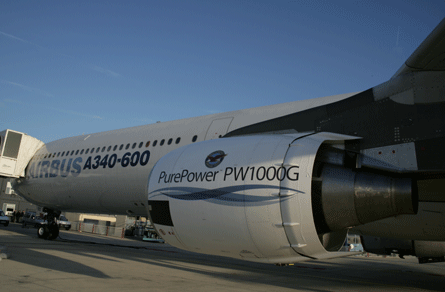Open rotor technology may promise the step-change economic and environmental benefits that the industry is clamouring for, but one company believes it has a simpler, lower-risk answer that will be much more straightforward to incorporate into airframe designs - Pratt & Whitney, with its GTF geared turbofan.
"When you look at issues like the installation, noise, and overall aerodynamic efficiency, does an open rotor really provide all of the benefits [over a conventional engine]?" asks Bob Saia, P&W vice-president next generation product family.
P&W has been developing the technology for two decades and last year completed extensive flight-test programmes of its full-scale demonstrator on its in-house Boeing 747SP and on Airbus's A340-600 development aircraft.
The first production version of the GTF, dubbed the PW1000G, is due to enter service in 2013 powering the Mitsubishi MRJ regional jet and Bombardier CSeries. The engine promises to deliver a 12-15% improvement in fuel burn range compared with today's engines as well as an impressive 20dB margin over Chapter 4 noise legislation.
 |
|---|
© Airbus |
But with rival advanced turbofan and open rotor designs on the drawing board that are expected to better the GTF's efficiency advantage, P&W is already working on an "Advanced GTF" that would be a candidate to power new-generation narrowbody replacements from Airbus and Boeing at the end of the next decade. "We'd like to improve fuel consumption by another 8-10%, so we'd be looking at a total of around 20%," Saia says.
Although the GTF, with its higher bypass ratio, would have a larger fan diameter than a conventional engine of similar thrust, Saia says it would have less impact on the fundamental design of the airframe, compared with an open rotor: "For an Airbus or Boeing narrowbody, today's geared engine would have a diameter of about 95in [2.4m]. For an open rotor, you're taking it to almost double the diameter - 14-17ft [4.3-5.2m].
"The open rotor's bigger blades means that the engine has to be installed a long way away from the wing or fuselage. So you've got the installation and aerodynamics associated with that, as well as the issue of community noise that the open rotor brings."
"Open rotors will be as noisy as engines introduced in the last century, so that a 2020 introduction of a new open rotor aircraft would be abandoning 20 years of engine noise reduction technology," says Alan Epstein, P&W vice-president technology and environment. "Such an open rotor will expose three times more people to objectionable noise levels than an advanced geared turbofan engine with the same fuel burn."
Saia says the next phase of GTF development will take the engine "to the open rotor fuel efficiency with a much smaller size". He adds that the GTF's noise advantage over today's engines means that airlines can get more utilisation out of the aircraft by using more direct departure routeings or operating outside night-time noise curfews.
Source: Flight International























